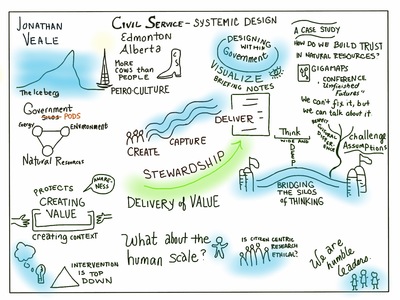The civil servant systemic designer: An emerging context for systemic design practice
Veale, Jonathan (2013) The civil servant systemic designer: An emerging context for systemic design practice. In: Relating Systems Thinking and Design 2013 Symposium Proceedings, 9-11 Oct 2013, Oslo, Norway.
Preview |
Text
Veale_Rich_2013.pdf Download (358kB) | Preview |
Preview |
Text
Veale_Presentation_2013.pdf Download (3MB) | Preview |
![Veale_MindMap_2013.jpg [thumbnail of Veale_MindMap_2013.jpg]](https://openresearch.ocadu.ca/2172/2.hassmallThumbnailVersion/Veale_MindMap_2013.jpg)  Preview |
Image
Veale_MindMap_2013.jpg Download (577kB) | Preview |
Abstract
Introduction. Government decisions manifest within the landscape and can greatly affect change within their jurisdiction and beyond. A perfect example would be decisions about regional energy policy. A government’s views about the production, transportation and consumption of energy within their geography notably impacts land development, resource extraction, economic investment, urban design, transportation, climate change, economic competitiveness and the social mix of a region . Energy policy decisions are foundational to complex predicaments, including energy insecurity, poverty, food and water security and social strife. Notable examples abound but this complexity manifests at the human scale towards whole systems and the spaces in-between.Until relatively recently, government policy development, insofar as it was systemic, relied upon hard systems methodology which began with a knowable problem and converged on a solution . This linear and monistic approach brought depth but lacked context of the wider societal, technological, economic, ecological and political system. In simpler times, and in the absence of complex systems methodologies, this approach was the best option for policy development. Consistent with this view, governments organized themselves around discrete policy silos, each bringing an expert depth to their thematic responsibility. This is opportune where increasing specialization leads to new knowledge, but challenged where context is needed to avoid unintended consequences . Complexity as it is now, calls upon government to navigate policy predicaments with a new architecture – one that brings both depth and context for rigorous policy.
This paper examines the emerging context of the civil servant – one entrusted with the public interest by duty and responsibility – who practices within the architecture of government, deploying systemic design methodologies towards the complex predicaments that societies faces. Governments are responding to complexity in policy decisions – design consultants are retained; government staff are trained in designerly ways; and, experienced-designers are employed on in-house consulting teams. These models have the effect of increasing the profile of design practice within government. The model of the Department of Energy in Alberta, Canada is examined with a view towards articulating this emerging context for systemic design practice. The case of a trans-ministry design team applying systemic design methodology around a shared strategic concern is presented
| Item Type: | Conference/Workshop Item (Paper) |
|---|---|
| Divisions: | Faculty of Design |
| Date Deposited: | 06 Feb 2018 14:29 |
| Last Modified: | 20 Dec 2021 18:45 |
| URI: | https://openresearch.ocadu.ca/id/eprint/2172 |
Actions (login required)
 |
Edit View |

 Tools
Tools Tools
Tools